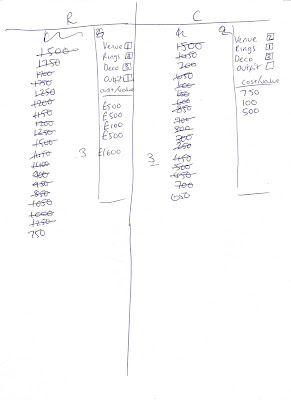The initial sketches of the board game didn't take too long to develop once I had the core foundations of the game down on paper. I appreciate that the image is hard to see, but there are three main aspects of the boards design - the ring (playing area), the diamond (starting point) and the card area. This engagement ring inspired board has the three main aspects of the game of which all the mechanics lie - the pass point, the item and venues spaces, the money spaces and the luck spaces.
THE DIAMOND
The diamond was a part of the game I wanted to include entirely for the aesthetics of the game, however considering the diamond is probably the most crucial part of an engagement ring, it didn't seem sensible to waste it on a visual gimmick. Thus, the diamond was utilized as an important part of the game, the starting point, the end point and the money point - the most important part of the game for the player. Or at least that was the idea.
THE PLAY PATH
The circular shape of the ring was, from the very start, an opportunity to lay the path for the players, therefore the board's layout was conceived. The circular board limits the game however - players will naturally expected the game to be continuous much the like the game monopoly, as there is no real start or end point for the board, thus there had to be a different goal that determined the games end. The simple goal of "Who gets to the end first wins" doesn't fit in context with the game, nor does it with the boards design, therefore the idea is that every cycle of the board represents a month, and by the end of three months, whichever team has the highest wedding value wins. I know at this point that the goal for the player is too complicated, as Scott Rogers stresses "You should be able to sum up the games objective quickly and clearly" (Level Up! The Guide To Great Video Game Design", 2010). This needs to be altered further in the development.
THE SPACES
Traditionally in board games, the spaces on the board contain attributes that affect the players - either detrimental or beneficial. There is no difference here - the player must pass four different types of spaces. This is familiar to the player and therefore simple to understand if they know the attributes of the spaces. In addition, each space has an assigned symbol, therefore once players understand the attributes, they understand the symbols without having to reference the rules.
- Blank Spaces: Blank Spaces have no effect on the player.
- Plus Spaces: Plus Spaces give the player £50 towards the player's budget,
- Minus Spaces: Minus Spaces take away £50 from the player's budget.
- Good Luck Spaces: Good Luck spaces add hundreds of pounds to the player's budget.
- Bad Luck Spaces: Bad Luck spaces take away hundreds of pounds from the player's budget,
- Venue Spots: Depending on the venue number, the player can choose to buy that venue at a set price.
- Item Spots: Depending on the item number, the players can choose to buy that item at a set price.
THE CARD SECTION
The idea is that each team keeps track of their balance whilst a separate section for each team keeps track of what they have bought and what their total wedding value is. At first sight it is a simple system, however, I have only play tested this with someone who watched me develop the game and therefore such a statement is biased. Having players with no involvement in the game will truly give me an invaluable insight into whether the game's mechanics, rules and system is simple and entertaining, as intended. The next step is polishing the game itself for play testing.


No comments:
Post a Comment